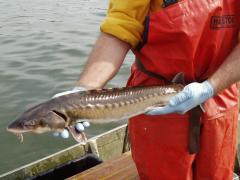Shortnose Sturgeon
The Delaware River provides critical habitat to New Jersey’s only endangered fish species – the shortnose sturgeon (Acipenser brevirostrum). It can be found throughout the Delaware River estuary, occasionally entering the nearshore ocean off Delaware Bay.
In the U.S., this species occupies estuaries, tidal rivers and bays along the Atlantic Coast from New Brunswick Canada to the St. John River in Florida. It is the smallest of three sturgeon species to occur in the eastern portion of North America.
 Zoom+ A Shortnose sturgeon is pictured before being released back into the Delaware River. © Hal Brundage
Zoom+ A Shortnose sturgeon is pictured before being released back into the Delaware River. © Hal Brundage
Sturgeon are often called living fossils since they are among the oldest bony fishes, retaining primitive characteristics such as a heterocercal tail where the upper lobe is larger and contains the upturned end of the spinal column, bony plates known as scutes, and mouth located on the underside of the head. To feed, shortnose sturgeon search the bottom sediment with whisker-like feelers known as barbells, sucking in crustaceans, mollusks, worms, insects and other organisms with a protractile mouth which can be extended or retracted at will. Shortnose sturgeon reach between 18-22 inches in length when fully grown. As with other sturgeon species, shortnose sturgeon can be long-lived. Females can live as long as 67 years, whereas the oldest known male was 32 years old.
A large portion of the Delaware River’s shortnose sturgeon population overwinter between Roebling and Trenton from December to March. In mid-to-late March, most adults move upstream to spawn. Spawning occurs between late March and early May from Trenton Rapids to Scudders Falls. Eggs are demersal – they are found on or near the bottom and adhesive. They hatch about 13 days after fertilization. Once sturgeon have spawned, they move downstream to near Philadelphia, where they will stay throughout May. They will then return upstream to the overwintering ground (which are also a summering area) and remain there through summer and winter.
The shortnose sturgeon has been federally listed as endangered since the inception of the Endangered Species Act in 1973.
Both shortnose and Atlantic sturgeon once thrived in the Delaware River, occurring in huge numbers that far exceeded those found in the Hudson. According to one author, “the advancing horde could virtually be skimmed off the bottom with seine nets.” In the late 1800’s populations were all but decimated by the caviar industry. During the American Caviar Rush between 1870 and 1900, stocks of shortnose and Atlantic sturgeon crashed in rivers along the east coast.
Although there are now about 12,000 adult shortnose sturgeon living within the Delaware River estuary, the population faces serious human-induced threats. Water quality contaminants such as endocrine distributing chemicals (EDCs) have been linked to reproductive and developmental disorders in many fish species. These contaminants were found in shortnose sturgeon tissue collected in 2001 and include PCDDs/TCDFs, DDE, PCBs and cadmium. Other threats to Delaware River shortnose sturgeon include heavy industrialization and waterfront development, ship/boat strikes, poaching, mortality from commercial and recreational fishing (bycatch), injury to early life stages from water intake systems, instream construction projects within the spawning area, and dredging, including the ongoing Delaware River deepening project (see Commentary on P. 2).
Recent work supported by the Endangered and Nongame Species Program (ENSP) confirmed successful reproduction of shortnose sturgeon over an 11 mile reach of the lower non-tidal Delaware River. Researchers identified critical spawning/nursery areas by capturing early life stages (eggs and larvae) using artificial substrates and plankton nets over two seasons. Additional work to determine whether spawning occurs upstream in the Lambertville area, where there is an abundance of suitable substrate and habitat, is scheduled to begin next year. Researchers will also track juvenile and adult sturgeon fitted with acoustic tags to further determine movement patterns and habitat use in the Delaware River and bay. This new research will supplement existing information on shortnose sturgeon migration and help biologists develop effective protection strategies and ultimately prevent further declines of this fragile species.
written by Jeanette Bowers-Altman, NJ ENSP Principal Zoologist








